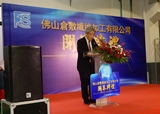 Kurashiki Textile Manufacturing Co., Ltd., a member of the Kurabo Group that manufactures nonwoven fabrics, disclosed that its new plant in Guangdong Province, China has commenced operations.
Kurashiki Textile Manufacturing Co., Ltd., a member of the Kurabo Group that manufactures nonwoven fabrics, disclosed that its new plant in Guangdong Province, China has commenced operations.
The nonwoven fabrics produced at this new plant will be used mainly for the filters of air purifiers. China’s domestic demand is robust, and the company is considering carrying out capacity expansion ahead of schedule.
Established in August last year as a wholly owned subsidiary (capital: US$1.9 million), it is the first overseas plant for the company. In the three-year business plan that started in fiscal year 2016, of which one of the main points is the expansion of overseas sales, the company has been promoting a plan to establish a base for producing composite nonwovens and functional processing in China, and expand domestic sales in China based on the policy of local production for local consumption. Markets such as ASEAN and Europe will be targeted in the future.
At the opening ceremony on July 12th, Katsumi Aoyama, President of Kurashiki Textile Mfg., announced a management policy that places an emphasis on quality and research & development, saying, “Firstly, our new plant will produce products with qualitative uniformity, which will contribute to greater yields for our customers and efficiency improvement by exhibiting superiority of quality. The development of functional products will also be accelerated with cooperation from Japan.”
The new plant will produce nonwovens mainly for the filters of air purifiers, centering on deodorization processing. Trial production is currently being carried out, and full-scale operations are scheduled from October. In addition to deodorization processing, other types of functional processing are possible, such as anti-allergen and antibacterial processing. In the future, the company will look at home appliances as well as automotive applications and so on.
Demand in China is robust, and orders exceed their expectation. When a feasibility study (commercialization survey) was made, the monthly production amount that was expected to be reached in three years is likely to be achieved during October-December 2017.
Accordingly, the company intends to establish a system in an early stage with importance attached to the education of employees, and will examine its next plans to undertake capacity expansion ahead of schedule.